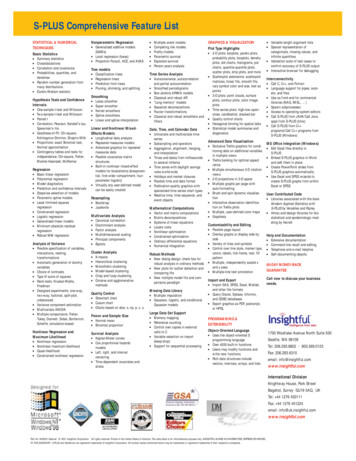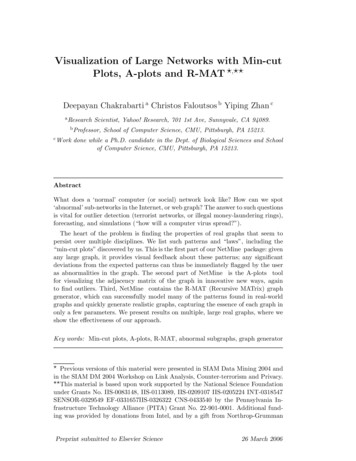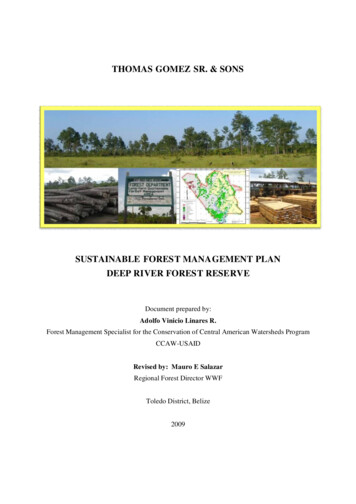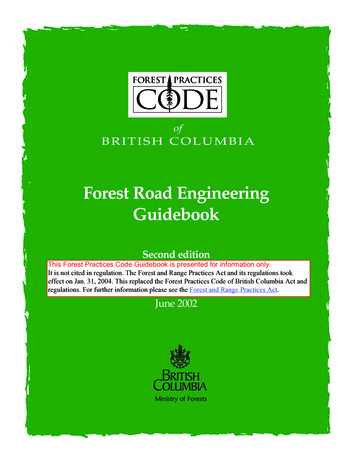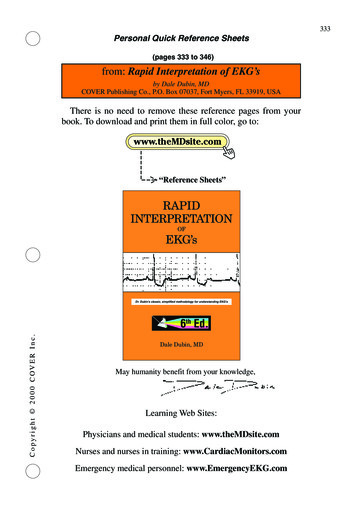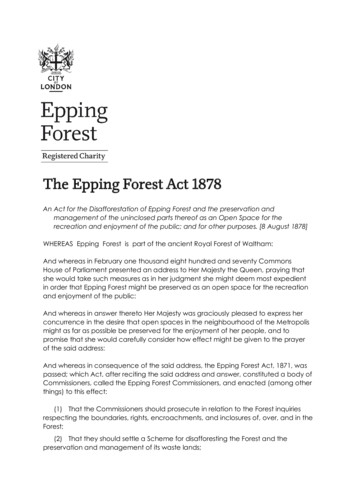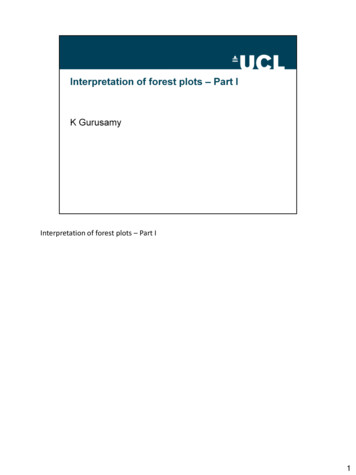
Transcription
Interpretation of forest plots – Part I1
At the end of this lecture, you should be able to understand the principles and uses offorest plot. You should also be able to modify the forest plots.2
What is a forest plot? Forest plots are graphical representations of the meta-analysis.The word originated from the idea that graph had a forest of lines. The plot originatedin the early eighties although the term forest plot was coined only in 1996. Forestplots in their modern form originated in 1998.3
What does a forest plot show? Each study represented by a line. Note that Study4 isnot represented by a line since there no events in either group. Such studies will beexcluded from the meta-analysis.4
There is a box in the line for each study. The mid-point of the box represents thepoint effect estimate, that is, the mean effect estimate for each study. The area of thebox represents the weight given to the study. This is designed so that eyes are drawntowards the studies that are given more weight. The diamond below the studiesrepresents the overall effect.5
The width of the line shows the confidence intervals of the effect estimate ofindividual studies. The width of the diamond shows the confidence intervals for theoverall effect estimate.6
What do point estimate and 95% confidence intervals mean? Point estimate is bestguess of the true effect in the population. 95% confidence intervals mean that thereis a 95% chance that the true effect in the population will lie within the range. Theyalso mean that if the trial is repeated, there is a 95% chance that the point estimatefrom the trial lies within the 95% confidence intervals obtained in the systematicreview. These are based on the sample being representative and the assumption thatthere are no systematic errors that can bias the results.7
The Forest plot also provides the summary data entered for each study. In addition, itprovides the weight for each study; the effect measure, method and the model usedto perform the meta-analysis; the confidence intervals used; the effect estimate fromeach study, the overall effect estimate, and the statistical significance of the analysis.For the time being, ignore the information on heterogeneity. This will be explained inthe next lecture.8
Note the other important information present in the forest plot. There is a verticalline which corresponds to the value 1 in the plot shown. This is the line of no effect.Note also that it says favours experimental to the left of the vertical line and ‘favourscontrol’ to the right of the vertical line. These are called labels of the forest plot.These labels can be edited. Before we learn how to edit the labels, it is necessary tounderstand what these mean and what labels should be used.9
This slide is to refresh the different effect measures that are commonly used fordifferent type of outcomes.10
All ratios commonly used as effect measures in meta-analyses are relative measures.In this case, 1 indicates no effect. If 1 is included in the 95% confidence intervals, itindicates that there is no statistical significance at 5% significance levels. If 1 is notincluded in the 95% confidence intervals, the results are statistically significant at 5%significance levels. This is applicable for effect estimates for the individual study leveland for the overall estimate. Whether the intervention is beneficial or harmfuldepends upon the context. The different situations that one faces when calculatingratios is shown in the next few slides.11
This slide shows an example of a bad event such as mortality. The 95% confidenceintervals of all the studies overlap 1. The 95% confidence intervals of the overalleffect estimate also overlaps 1. So, there is no statistical significance either at thestudy level or the meta-analysis level. Note that for a bad event, the label ‘favoursintervention’ is on the left of the line of no effect and the label ‘favours control’ is onthe right of the line of no effect.12
The 95% confidence intervals of all the studies overlap 1. The 95% confidenceintervals of the overall effect estimate does not overlap 1. So, there is no statisticalsignificance at the study level but there is statistical significance at the meta-analysislevel. Intervention is better as the overall effect estimate and its 95% confidenceintervals are to the left of the line of no effect.13
The 95% confidence intervals of all the studies except those of one study overlap 1.The 95% confidence intervals of the overall effect estimate overlaps 1. So, there is nostatistical significance at the study level except for the one study. In this study markedwith a red ellipse in the slide, the intervention is better than the control. There is nostatistical significance at the meta-analysis level.14
The 95% confidence intervals of all the studies except one study overlap 1. The 95%confidence intervals of the overall effect estimate does not overlap 1. So, there is nostatistical significance at the study level except for the one study. There is statisticalsignificance at the meta-analysis level. Intervention is better as the overall effectestimate and its 95% confidence intervals are to the left of the line of no effect.15
The 95% confidence intervals of all the studies except one study overlap 1. The 95%confidence intervals of the overall effect estimate does not overlap 1. So, there is nostatistical significance at the study level except for the one study. There is statisticalsignificance at the meta-analysis level. Intervention is worse than control as theoverall effect estimate and its 95% confidence intervals are to the right of the line ofno effect.16
Note that for a good event such as early return to work, the label ‘favoursintervention’ is on the right of line of no effect and the label ‘favours control’ is on theleft of the line. It is important to note that this does not happen automatically andhas to be done manually. This will be shown in one of the later slides in this lecture.On the forest plot shown, the 95% confidence intervals of all the studies except onestudy overlap 1. The 95% confidence intervals of the overall effect estimate does notoverlap 1. So, there is no statistical significance at the study level except for the onestudy. There is statistical significance at the meta-analysis level. Intervention is betterthan control as the overall effect estimate and its 95% confidence intervals are to theright of the line of no effect.17
This table summarises the interpretation of forest plot when ratios are used as effectmeasures.18
All differences commonly used as effect measures in meta-analyses are absolutemeasures. In this case, 0 indicates no effect. If 0 is included in the 95% confidenceintervals, it indicates that there is no statistical significance at 5% significance levels. If0 is not included in the 95% confidence intervals, the results are statisticallysignificant at 5% significance levels. This is applicable for effect estimates for theindividual study level and for the overall estimate. Whether the intervention isbeneficial or harmful depends upon the context. The different situations that onefaces when calculating differences and the interpretation is shown in the next fewslide.19
This table summarises the interpretation of forest plot when differences are used aseffect measures. The interpretation is pretty much the same as for ratios. The onlydifference is that the line of no effect is at zero for differences while it is at 1 forratios.20
Although a forest plot is generated as soon as you enter the data, a separate forestplot can be generated by clicking on the icon shown.21
From the resulting window, one can save, copy, or print the forest plot.22
Now that the labels for different situations has been explained, it is necessary thatyou learn to make the changes in forest plots generated by RevMan. Double click theoutcome. Click on the cogwheels in right upper region. This opens up a window withwhich you should be familiar by now. Click on the graph tab.23
You can edit the left graph label and the right graph label. You can also add units formean difference. There are no units for other effect measures.24
The point estimates and most, if not all, of the confidence intervals should be visiblein the plot. The point estimates should be of reasonable size. This can be done byadjusting the slider, shown as red circle.25
Forest plots should not be used when there are no studies reporting the outcome.The Cochrane Collaboration discourages the use of forest plots if there is only onestudy reporting the outcome.26
In this lecture, basic principles of interpretation of forest plots and the way they canbe modified was demonstrated. Please complete the exercise in the next slide.Discuss the results of your exercise with your course tutor. If you have any otherdoubts related to the lecture, please discuss with your course tutor.27
28
29
left of the line. It is important to note that this does not happen automatically and has to be done manually. This will be shown in one of the later slides in this lecture. On the forest plot shown, the 95% confidence intervals of all the studies except one study overlap 1. The 95% confidence intervals of the overall effect estimate does not
